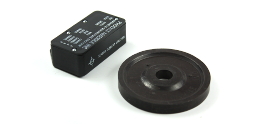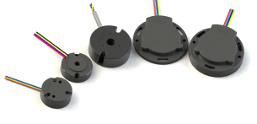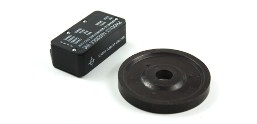Magnetic Encoder Supplier
Phoenix America LLC rotary magnetic encoders employ magnetic-based technology reaching multiple channel outputs with resolutions topping 10,000 pulses per revolution. Phoenix America LLC's unique magnetic encoder design eliminates the challenge and expense of conventional encoder bearing systems along with associated brackets, couplers and mounts. You won’t find specifications on bearing materials and bearing life on Phoenix America's magnetic encoders since they don’t need to employ a separate bearing system. Your shaft and bearing system are all that is necessary.
Magnetic Encoder Basics
Magnetic Encoders have a large magnetized wheel spin over a plate of magneto-resistive or hall element sensors. Just as the disk spins over the mask to let light through in predictable patterns, the wheel causes predictable responses in the sensor, based on the strength of the magnetic field. The magnetic response is fed through a signal conditioning electrical circuit. The number of magnetized poles can vary with the pulse count needs of an application. For higher pulse counts, a mathematical interpolation process is used by interrogating the arc tangent values of sine/cosine patterns created by the magnetic strength plots from each pole pair.
Magnetic Encoder Applications
A magnetic encoder is designed to output reliable digital feedback in the most demanding and harshest environments. Applications for this technology usually require broad temperature specs, robust sealing, high shock and vibration resistance, and contaminant protection all while focusing on output signal reliability, easy installation, and downtime reduction. Popular applications for magnetic encoders include position and velocity feedback in Steel, Pulp, Paper, Lumber mills, industrial automation and assembly systems, metalworking, stone-cutting, sawing, textiles, plastics processing, woodworking, packaging, and electronic chip/board production.
Magnetic v. Optical Encoders
In the past, optical encoders were the primary choice for high-resolution applications but improvements in magnetic encoder technology now allow them to achieve resolutions down to a micron, competing with optical encoders in many applications. Compared to optical encoders, magnetic encoders are more robust and can handle hard environments making them ideal for industrial environments. Another unique advantage of magnetic encoder technology over other encoder technology comes from the fact that magnetic encoders do not require moving parts such as bearings or seals, the main cause of encoder failure. Magnetic encoders are comprised of only two major components that require no special compliant adaptation components such as coupling and straps for mounting.
Click to Contact us Today or call us at 866.315.7032






